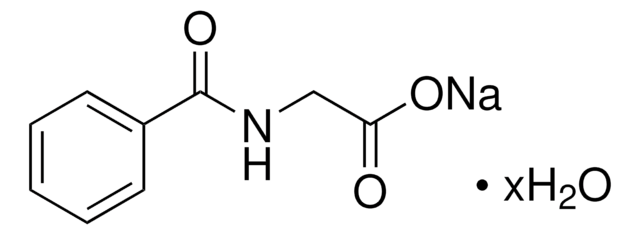B85919
(±)-2-Butanol
ReagentPlus®, ≥99%
Sinónimos:
sec-Butyl alcohol
About This Item
Productos recomendados
vapor density
2.6 (vs air)
Quality Level
vapor pressure
12.5 mmHg ( 20 °C)
product line
ReagentPlus®
assay
≥99%
form
liquid
autoignition temp.
761 °F
expl. lim.
9.8 %
IVD
for in vitro diagnostic use
refractive index
n20/D 1.397 (lit.)
bp
98 °C (lit.)
mp
−115 °C (lit.)
density
0.808 g/mL at 25 °C (lit.)
SMILES string
CCC(C)O
InChI
1S/C4H10O/c1-3-4(2)5/h4-5H,3H2,1-2H3
InChI key
BTANRVKWQNVYAZ-UHFFFAOYSA-N
¿Está buscando productos similares? Visita Guía de comparación de productos
Categorías relacionadas
General description
Application
- As a precursor to produce 2-butanone in presence of KMnO4 oxidant and CPC (N-cetylpyridinium chloride) micellar catalyst.
- In the production of CH3NH3PbI3 perovskite films.
Legal Information
signalword
Warning
hcodes
Hazard Classifications
Eye Irrit. 2 - Flam. Liq. 3 - STOT SE 3
target_organs
Central nervous system, Respiratory system
Storage Class
3 - Flammable liquids
wgk_germany
WGK 1
flash_point_f
80.6 °F - closed cup
flash_point_c
27 °C - closed cup
Certificados de análisis (COA)
Busque Certificados de análisis (COA) introduciendo el número de lote del producto. Los números de lote se encuentran en la etiqueta del producto después de las palabras «Lot» o «Batch»
¿Ya tiene este producto?
Encuentre la documentación para los productos que ha comprado recientemente en la Biblioteca de documentos.
Los clientes también vieron
Nuestro equipo de científicos tiene experiencia en todas las áreas de investigación: Ciencias de la vida, Ciencia de los materiales, Síntesis química, Cromatografía, Analítica y muchas otras.
Póngase en contacto con el Servicio técnico









